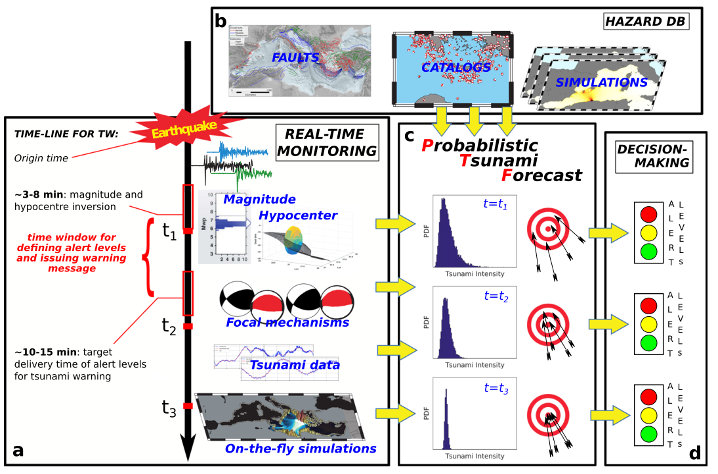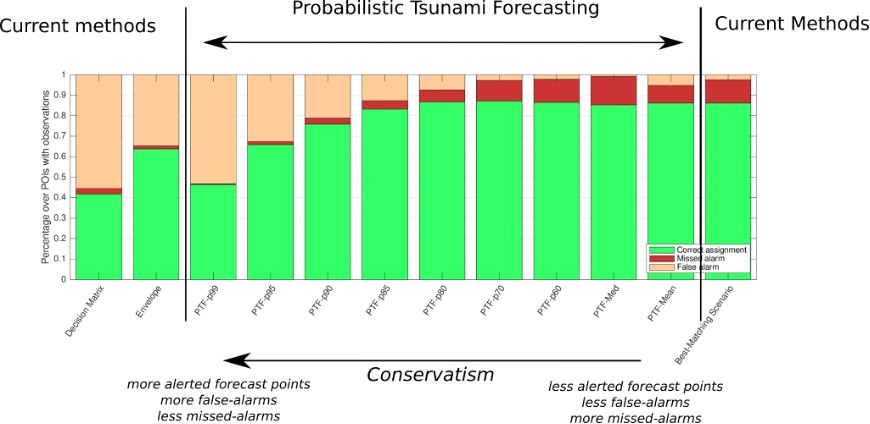An international team coordinated by INGV presents a new model for tsunami early warning following an earthquake
An international team coordinated by INGV presents a new model for tsunami early warning following an earthquake
Realized a forecasting model that includes a quantitative estimate of uncertainties, linking it to the definition of tsunami alert levels
The Probabilistic Tsunami Forecasting (PTF) is the innovative procedure that allows, in real time, the determination of the tsunami alert level taking into account the inevitable uncertainty on the forecast of the tsunami. The procedure, which could introduce a paradigm shift in the management of tsunami alerts, was developed by an international research team coordinated by the Istituto Nazionale di Geofisica e Vulcanologia (INGV - National Institute of Geophysics and Volcanology) and it has just been published in the study “Probabilistic tsunami forecasting for early warning” in the scientific journal ‘Nature Communications’.
“The PTF quantifies the probability of occurrence of a tsunami with a given intensity within a few minutes after the shock capable of generating it", explains Jacopo Selva of the INGV Tsunami Warning Center (Centro Allerta Tsunami, CAT-INGV) and first author of the article. The method developed by the researchers rigorously and for the first time evaluates the unavoidable degree of uncertainty in real-time tsunami forecasts. “This offers the possibility to link the definition of the alert levels for tsunami early warning to the forecast of the intensity of the possible tsunami and to the relative uncertainty, based on pre-established risk reduction criteria”, adds Jacopo Selva.
“The forecasts are made by combining the earthquake parameters estimated in real-time with those expected in the area and, finally, with millions of numerical simulations of the tsunami propagation pre-calculated thanks to modern supercomputers”, adds Stefano Lorito, co-author of the study.
The research team applied the PTF, a posteriori, to several seismic events, including the 8.8 magnitude earthquake that hit Maule, Chile, in 2010, the Zemmouri-Boumerdes tsunami, Algeria, generated in 2003 by an earthquake of magnitude 6.8, and the recent tsunami generated almost a year ago by the earthquake of magnitude 7.0, which occurred near the Greek island of Samos. All the earthquakes located in the Mediterranean area that have activated the INGV CAT in recent years were also analyzed. This made it possible to evaluate the accuracy of the forecasting model over a wide range of magnitudes and types of the seismic event, from relatively small crustal earthquakes to larger events generated in subduction areas.
In order to be able to offer, in case of an event, an adequate response to citizens residing in coastal areas exposed to the risk of flooding from a tsunami, it is essential to combine the scientific evidence with political choices that are needed to link an alert level to a given probability, considering that each alert level, in turn, can correspond to certain coastal areas to be evacuated. The latter, in Italy, have been defined by ISPRA, INGV, and DPC, which are the components of the SiAM (“Sistema di Allertamento nazionale per i Maremoti generati da sisma”, the National Alert System for Tsunamis generated by earthquakes). Indeed, both missed and false alarms can generate significant socio-economical consequences. Given that both cases are due to the uncertainty in the prediction of hazardous events, the PTF aims at integrating the uncertainty itself into calculations.
This approach in the future may be useful also for the definition of new strategies of risk management, allowing, for example, the definition of different mitigation actions for specific issues based on the scientific information provided in real-time by the PTF such as, for example, the activation of procedures to safeguard industrial plants in cases of emergency.

Figure 1. The PTF integrates information derived from real-time monitoring with information on expected earthquakes in the area and, finally, with millions of numerical simulations of tsunami propagation pre-calculated thanks to modern supercomputers, providing estimates that may be updated over time, allowing a reduction of the uncertainty.

Figure 2. The quantifications produced by the PTF can be linked to the different alert levels of the early warning system, accounting for the actual uncertainties at the time of the estimate. This allows to define the alert level taking into account the potential number of false or missed alarms resulting from the unavoidable uncertainty that exists in the first minutes after the earthquake









































